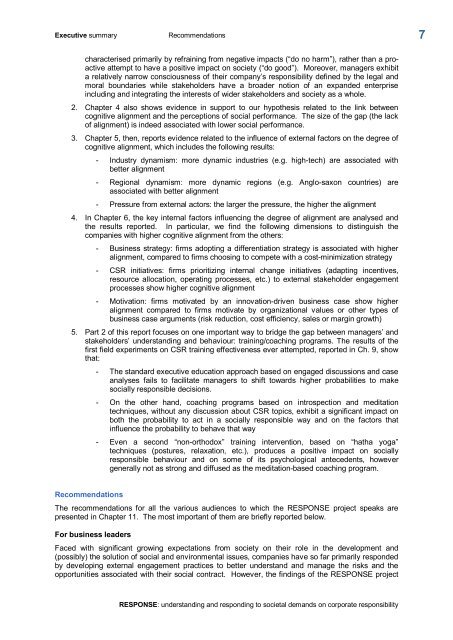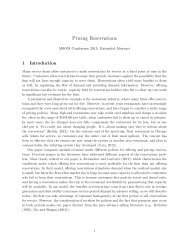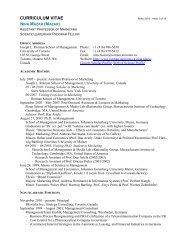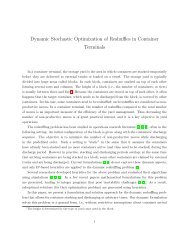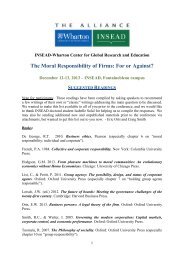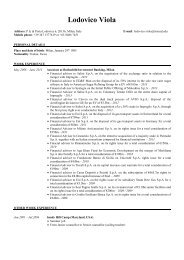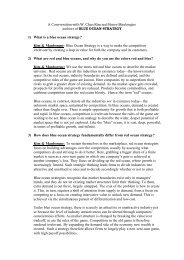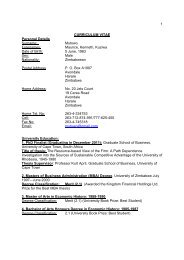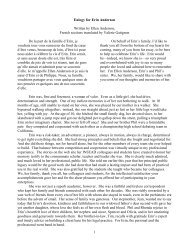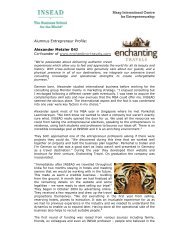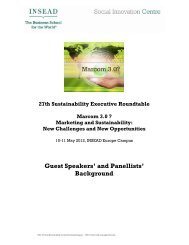RESPONSE - Insead
RESPONSE - Insead
RESPONSE - Insead
Create successful ePaper yourself
Turn your PDF publications into a flip-book with our unique Google optimized e-Paper software.
Executive summary Recommendations<br />
characterised primarily by refraining from negative impacts (“do no harm”), rather than a pro<br />
active attempt to have a positive impact on society (“do good”). Moreover, managers exhibit<br />
a relatively narrow consciousness of their company’s responsibility defined by the legal and<br />
moral boundaries while stakeholders have a broader notion of an expanded enterprise<br />
including and integrating the interests of wider stakeholders and society as a whole.<br />
2. Chapter 4 also shows evidence in support to our hypothesis related to the link between<br />
cognitive alignment and the perceptions of social performance. The size of the gap (the lack<br />
of alignment) is indeed associated with lower social performance.<br />
3. Chapter 5, then, reports evidence related to the influence of external factors on the degree of<br />
cognitive alignment, which includes the following results:<br />
Industry dynamism: more dynamic industries (e.g. hightech) are associated with<br />
better alignment<br />
Regional dynamism: more dynamic regions (e.g. Anglosaxon countries) are<br />
associated with better alignment<br />
Pressure from external actors: the larger the pressure, the higher the alignment<br />
4. In Chapter 6, the key internal factors influencing the degree of alignment are analysed and<br />
the results reported. In particular, we find the following dimensions to distinguish the<br />
companies with higher cognitive alignment from the others:<br />
Business strategy: firms adopting a differentiation strategy is associated with higher<br />
alignment, compared to firms choosing to compete with a costminimization strategy<br />
CSR initiatives: firms prioritizing internal change initiatives (adapting incentives,<br />
resource allocation, operating processes, etc.) to external stakeholder engagement<br />
processes show higher cognitive alignment<br />
Motivation: firms motivated by an innovationdriven business case show higher<br />
alignment compared to firms motivate by organizational values or other types of<br />
business case arguments (risk reduction, cost efficiency, sales or margin growth)<br />
5. Part 2 of this report focuses on one important way to bridge the gap between managers’ and<br />
stakeholders’ understanding and behaviour: training/coaching programs. The results of the<br />
first field experiments on CSR training effectiveness ever attempted, reported in Ch. 9, show<br />
that:<br />
Recommendations<br />
The standard executive education approach based on engaged discussions and case<br />
analyses fails to facilitate managers to shift towards higher probabilities to make<br />
socially responsible decisions.<br />
On the other hand, coaching programs based on introspection and meditation<br />
techniques, without any discussion about CSR topics, exhibit a significant impact on<br />
both the probability to act in a socially responsible way and on the factors that<br />
influence the probability to behave that way<br />
Even a second “nonorthodox” training intervention, based on “hatha yoga”<br />
techniques (postures, relaxation, etc.), produces a positive impact on socially<br />
responsible behaviour and on some of its psychological antecedents, however<br />
generally not as strong and diffused as the meditationbased coaching program.<br />
The recommendations for all the various audiences to which the <strong>RESPONSE</strong> project speaks are<br />
presented in Chapter 11. The most important of them are briefly reported below.<br />
For business leaders<br />
Faced with significant growing expectations from society on their role in the development and<br />
(possibly) the solution of social and environmental issues, companies have so far primarily responded<br />
by developing external engagement practices to better understand and manage the risks and the<br />
opportunities associated with their social contract. However, the findings of the <strong>RESPONSE</strong> project<br />
<strong>RESPONSE</strong>: understanding and responding to societal demands on corporate responsibility<br />
7


